[Note: User Passerby interpreted the datasheet differently than I did, and he is correct. My answer will work, but his is the better way to do this. My answer does have some good info, though!]
The quick answer is that you need to create a short across SB1 ("solder-blob 1"). As you can see by the name, they intend that you just drop some solder between the two contacts.
Here's why:
First, the rules of USB:
The USB specification dictates that a device (the Nucleo in this case) will only draw 100mA max when first connected to a host (the computer or power source). After connection, if the device determines that it is allowed to take more current, it can do so. Generally this higher current is 500mA (max) although there are further exceptions that allow more current.
The host device dictates to the device how much current it can draw. It is the responsibility of the device, not the host, to limit current consumption.
There are various methods for the device to know how much current it is allowed to draw. Here is a nice document by Maxim that describes the details. Here's my quick and incomplete summary:
If the device is plugged into a computer, USB hub, etc, then there is an intelligent conversation that takes place between the device and host. This is called "enumeration". During the enumeration the device can let the host know that it wants more than 100mA. The host may then grant permission for the device to draw more.
If the device is plugged into a non-intelligent port (wall wart, battery pack, etc) then enumeration can't take place. There are a few schemes where the device can determine that high-current is available. They are shown in that Maxim doc.
Second: How the Nucleo implements these rules:
However, the Nucleo board doesn't implement the second option. It simply won't power up the main microcontroller until an enumeration takes place. This is described in the user manual, section 5.3.1. There is a jumper (JP1) that you can use to enable the main microcontroller without enumeration. Unfortunately this jumper also limits the current draw to 100mA! You can't have high-current and non-enumeration at the same time. Here is a portion of that section:

There is a solution, however! Find T2 on the schematic. It's the MOSFET in the lower-left of the first page. SB1 is right next to it. If you short over SB1 then the main microcontroller will always be powered. It is now your responsibility to always plug into a 500-mA capable port :)
Note also that the doc says that 300mA is all that is possible. Perhaps they've used a voltage regulator that can't regulate the full 500mA, or maybe they're reserving the extra current overhead for the non-user-accessible features of the Nucleo... Either way, I wouldn't try to exceed it.

